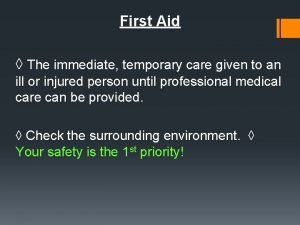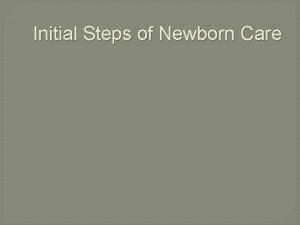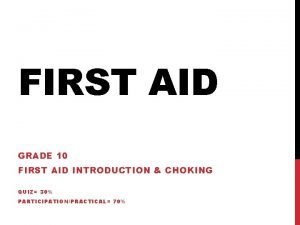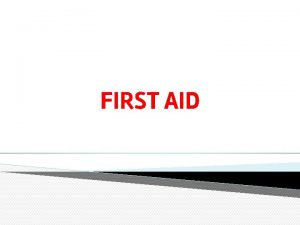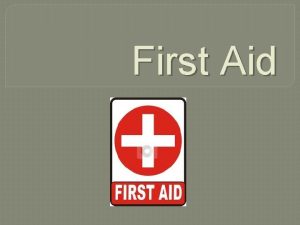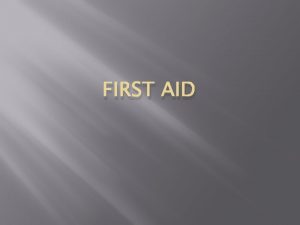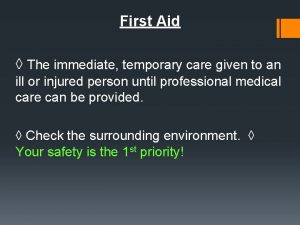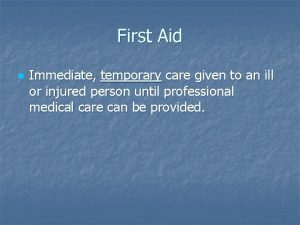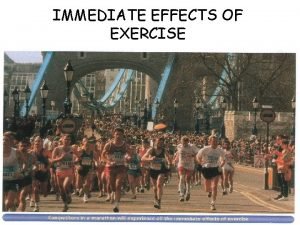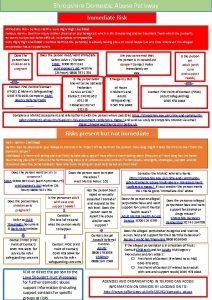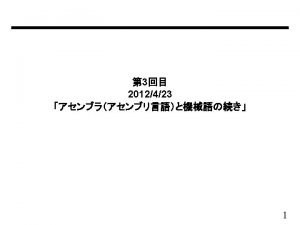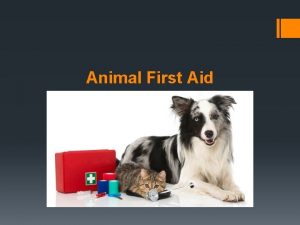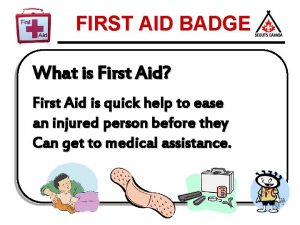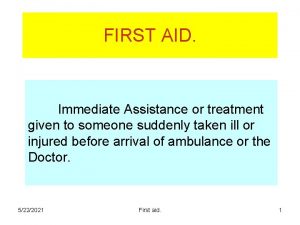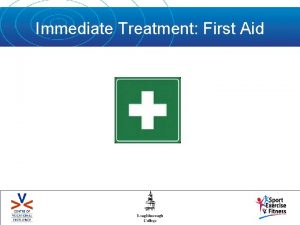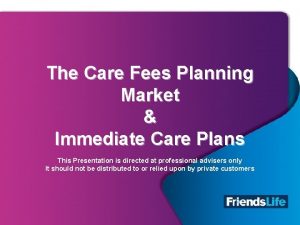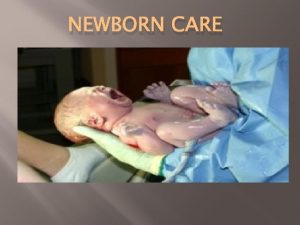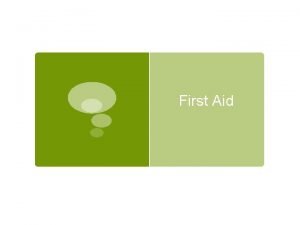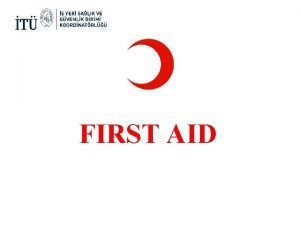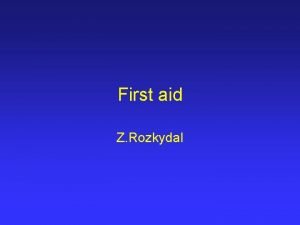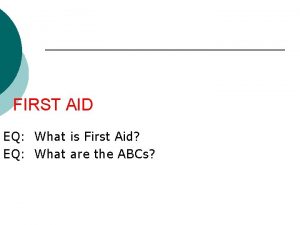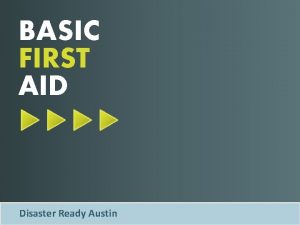First Aid First aid is the immediate care














































- Slides: 46

First Aid First aid is the immediate care given to a person who has been injured or suddenly becomes ill. ¢ Being skilled in first aid procedures can help you: ¢ Take safe actions to reduce your risk of illness or injury l Prepare to respond in an emergency l

Consent Actual consent- oral or written permission from a mentally competent adult ¢ Implied consent- unspoken understanding that first aid may be given if no one can give actual consent is conscious or present ¢

Check, Call, Care 1. Check the scene. l l 3. Care for injured Is there anything dangerous victims. or life-threatening to me or others involved? How many people are involved? 2. Call for help. l l Call 911 Remain calm, speak clearly, describe exact location of the emergency, listen carefully l l Care for the most injured victim first. Do not give any First Aid that you are not trained in. (Esp. CPR)

Head Injuries ¢ With a head injury always suspect neck injury as well. Do NOT move or twist the spine or neck. 1. Have victim rest, lying flat. Keep victim quiet and warm. If the victim starts to vomit, turn the head and body to one side, keeping the head and back in a straight line with the trunk. Watch victim closely. Do not leave the victim alone. 2. 3.

Head injuries continued… 4. 5. If any of these symptoms are present call 911: unconscious, seizure, neck pain, victim cannot respond to commands, victim is unable to move or feel arms or legs, blood is freely flowing from head, victim is sleepy or confused. Check for breathing. CPR may need to be given.


Neck and Back Injuries ¢ 1. 2. 3. 4. 5. If the victim walks to you with neck/back injury… Have victim lie down on his/her back. Support head by holding it in “face forward” position. TRY NOT TO MOVE HEAD OR NECK Do not move victim. Call 911


Bleeding 1. 2. Cover wound with clean bandage or sterile dressing and apply direct pressure. Add more cloths if the blood soaks through. Do not remove the first piece of cloth. Do not remove any foreign objects that are deep in the wound. Raise wounded body part above level of heart.

Bleeding continued… 3. Cover the cloth with a roller or sterile dressing with a roller bandage. 4. If bleeding doesn’t stop, continue to apply direct pressure, add pressure to pressure point Wear gloves! Do not touch mouth, eyes, or nose while caring for victim! Wash hands after care is given! ¢


Broken Bone ¢ 1. 2. 3. 4. 5. Signs: pain, swelling, loss of movement, deformity Treat for bleeding and shock. Keep injured part from moving. Use a splint when appropriate. Keep a victim with a head injury still Apply ice to the break to prevent swelling. Follow universal precautions for bleeding. Get prompt medical help.


Shock ¢ Shock is a dangerous change in blood flow to the body. ¢ Signs: Rapid, shallow breathing; cold, clammy skin; rapid, weak pulse; dizziness; weakness; fainting 1. Have victim lie down. Elevate legs about 8 -12 inches above level of heart unless you suspect head, neck, or back injuries or broken bone in hips or legs. Leave victim lying flat if you are unsure of injuries.

Shock continued… 2. Improve victim’s circulation. l l l 3. 4. 5. Keep airway open Perform rescue breathing if necessary. Perform CPR if necessary. Control of external bleeding. Help victim maintain normal body temperature. Cover victim with blanket if needed. Do not give the victim anything to eat or drink!


Heart Attack ¢ Signs of a heart attack: l l l Chest pain or discomfort lasting more than 3 -5 minutes or that goes and comes away. Pain is not relieved by rest, changing position, or medication. Pain may spread to shoulder, arm, back, neck, or jaw Dizziness or unconsciousness Ache, heartburn, indigestion Trouble breathing. Breathing is often faster than normal, extreme shortness of breath Nausea Sweating or changes in skin appearance


Heart Attack cont… 1. 2. 3. 4. 5. Call 911 Keep victim in a “comfortable” position, usually sitting or lying down with head and chest elevated. Loosen tight clothing especially around chest area. Monitor pulse and respiration. If no pulse, perform CPR

Heat Related Illnesses ¢ Heat related illnesses are conditions that result from exposure to temperatures higher than normal. ¢ HEAT CRAMPS: painful muscle spasms in the legs and arms due to excessive fluid loss through sweating. 1. 2. 3. Have victim rest in a cool, shaded area. Give victim cool water to drink. Stretch the muscle gently.

Heat Related Illnesses cont… ¢ HEAT EXHAUSTION: extreme tiredness due to the body’s inability to regulate its temperature. Signs include low body temperature; cool, moist, pale or red skin; nausea; headache; dizziness; fast pulse; weakness 1. 2. 3. 4. 5. Call 911 Have victim rest in a cool place. Have victim lie down and elevate feet. Give victim cool water to drink. Observe the victim for signs of heat stroke.

Heat Related Illnesses cont… ¢ HEAT STROKE: an overheating of the body that is life-threatening. Signs: sweating ceases, high body temperature, rapid pulse and respiration, skin is hot and dry, weakness, dizziness, headache, unconsciousness 1. 2. 3. 4. 5. 6. Call 911 Have victim rest in a cool place. Remove heavy clothing. Place ice packs near the neck, armpits, and groin. Continue cooling the victim until the body temperature is 102 F is reached. Treat life-threatening emergencies.


Cold Related Illnesses ¢ Cold related illnesses are conditions that result from exposure to low temperatures. ¢ FROSTBITE is the freezing of body parts such as fingers, toes, ears, nose, etc. Signs: numbness, waxy appearance of skin, skin discolored, cold skin. 1. 2. 3. Do attempt to rewarm if a medical facility is nearby. Take the following steps if medical help is not available. Remove any clothing or jewelry that interferes with circulation. Handle the affected area gently.

Cold Related Illnesses cont… 4. 5. 6. 7. 8. 9. Soak the affected area in water that is between 100 and 105 degrees. Rewarming usually takes 25 to 40 minutes, until the tissues are soft. Apply warm, moist clothes to warm the ears, nose, or face. Do not rub the affected area. Do not allow the victim to walk on frostbitten toes or feet, even after rewarming. Slightly elevate the affected area. Place dry, sterile gauze between toes and fingers to absorb moisture and avoid having them stick.


Cold Related Illnesses cont… ¢ HYPOTHERMIA: reduction of the body temperature so that it is lower than normal. Signs: shiver, feel cold, slower pulse, irregular pulse, unconsciousness 1. 2. 3. 4. 5. 6. Call 911 Get the victim into a warm environment Handle the victim gently Remove any wet clothing, and replace it with dry clothing. Place something warm above and below the victim, such as blankets. Cover the victim’s head.

Cold Related Illnesses cont… ¢ 7. 8. For mild hypothermia (body temp above 90 degrees): Warm the victim. Use an electrical blanket or tub of water no more than 105 degrees. Keep the victims legs and arms out of the water. Do not cover arms and legs with electric blanket. Place hot packs on victim’s head, neck, chest, and groin. Be careful not to burn the victim.

Cold Related Illnesses cont… ¢ 9. 10. 11. 12. For profound hypothermia (body temp is below 90 degrees) Do not rewarm a victim who can be transported to a medical facility within 12 hours. Calm the victim. Move the victim as little as possible. Do not give CPR unless they aren’t breathing.

Choking What to do if YOU are choking: Get the attention of someone around you. Use the universal distress signal. 2. Give yourself abdominal thrust if no one can help you. Make a fist with one hand grab the fist with your other hand. Give yourself five quick abdominal thrusts. Apply pressure inward and push up toward your diaphragm in one smooth movement. Repeat until the object is dislodged. 1.

Choking continued. . . If an adult or older child is conscious and choking Ask victim if (s)he is choking. Do not do anything if victim can speak or cough easily. Encourage the victim to continue coughing. If victim cannot speak, breathe, or cough. . . 2. Using the heel of your hand, give five back blows between the person's shoulder blades 3. Stand behind victim and wrap your hand around victim’s waist. Make a fist with one hand. Place thumb side of fist into victim’s abdomen above navel and below rib cage. Grab your fist with other hand. 1.

Choking continued. . . Give five quick abdominal thrusts. Apply pressure inward and push up toward victim’s diaphragm in one smooth movement. Repeat the cycle of five back blows and five abdominal thrust until object is dislodged. ▪ The victim might need CPR after the object is dislodged. ▪ Stay with victim and watch for breathing difficulties. 3.

Poisons/Overdose Poisoning can happen when a person swallows a poison, breathes a poison, injects a poison, has poison on the skin that is absorbed into the body. Signs: difficulty breathing, nausea, vomiting, chest and abdominal pain, sweating, seizures, skin rashes, and burns on lips or tongue 1. Be cautious. Protect your health and safety. Do not risk injury. Move the victim to a safe location if necessary. 3. Treat the victim for life-threatening emergencies. ▸ Keep victim’s airway open. Perform CPR if necessary. 2.

Poison continued. . . Gather information about cause of poisoning. Determine the type of poison. Ask the victim what the type of poison might be. Be on the lookout for empty bottles and containers or needles. Try to determine how much poison has been taken and when. Recognize fumes and odors that might be the cause. Be alert to the environment. Are there bees, snakes, or poisonous plants in the area? ▪ A poison control center can help as well. ▪ 1 -800 -222 -1222 4.

Allergic Reactions ¢ Signs of allergic reaction: hives all over body, weakness, seizures, dizziness, loss of consciousness, difficulty breathing, flushed face, paleness, confusion, blueness around eyes and mouth, drooling 1. 2. Call 911 Give victim medication if he/she requires it. Ex: Epi. Pen

Allergic Reactions cont… 3. 4. 5. 6. Have victim lie on his/her back with legs elevated above level of the heart. Loosen tight clothing. Give victim a blanket. Do not give the victim anything to eat or drink. If there is vomiting or bleeding, turn the person on his/her side to prevent choking. Give CPR if necessary.


Seizures ¢ ¢ 1. 2. 3. Seizures can be caused by epilepsy, overdose of poisons, drugs, alcohol, or head injury. Symptoms: convulsions, stiffening and jerking of the body, twitching, loss of bladder control, spaced out look Place victim on floor. Do not restrain movements if convulsing. Do not place anything between the teeth or give anything by mouth.

Seizures cont… 4. 5. Observe details such as duration, movements, behavior, body parts involved and report to medical services/guardians/victim. If the victim has a seizures lasting longer than 5 minutes, one following another, and/or has seizure without a history of seizures call 911.


Burns First Degree Burn: affects top layer of skin 1. Stop the burning. Get victim out of sun. Put out flames that are burning clothes or skin. 2. Cool burned area with water as soon as possible. Use sheets or towels soaked in cold water to cool a burn on face or other areas that cannot be soaked. Continue to soak with cool water. 3. Wear disposable gloves. Loosely bandage area with dry, sterile dressing. 4. Place cotton or gauze between fingers and toes.


Burns continued. . . Second-degree burn: affects top layers of skin 1. Stop the burning. Remove victim from source of burn. 2. Cool burned area with cool water or cold cloths. Keep cover loose. This helps prevent infection and reduces pain. Do not break blisters or remove tissue. 3. Raise the burned area above level of heart. 4. Cover victim with clean, dry sheets if burns cover large parts of the body. Treat for shock.


Burns continued. . . Third-Degree Burn: affects all layers of skin and some underlying tissue Treat for shock. 2. Check immediately if victim is breathing. Give CPR is necessary. Do not open blisters or remove pieces of tissue. Do not apply cold cloths or cool water. 3. Cover the burned area with a dry, sterile bandage, clean cloth, or sheet. 1.

 First aid merit badge first aid kit
First aid merit badge first aid kit An immediate and temporary care given to a person
An immediate and temporary care given to a person Apgar meaning
Apgar meaning Five initial steps of newborn care
Five initial steps of newborn care Early essential newborn care
Early essential newborn care Health care levels primary secondary tertiary
Health care levels primary secondary tertiary Pa wc bureau
Pa wc bureau Emergency care first aid and disasters
Emergency care first aid and disasters First aid in the first grade
First aid in the first grade St andrew medical centre
St andrew medical centre Hát kết hợp bộ gõ cơ thể
Hát kết hợp bộ gõ cơ thể Lp html
Lp html Bổ thể
Bổ thể Tỉ lệ cơ thể trẻ em
Tỉ lệ cơ thể trẻ em Chó sói
Chó sói Glasgow thang điểm
Glasgow thang điểm Chúa sống lại
Chúa sống lại Các môn thể thao bắt đầu bằng từ đua
Các môn thể thao bắt đầu bằng từ đua Thế nào là hệ số cao nhất
Thế nào là hệ số cao nhất Các châu lục và đại dương trên thế giới
Các châu lục và đại dương trên thế giới Công thức tính thế năng
Công thức tính thế năng Trời xanh đây là của chúng ta thể thơ
Trời xanh đây là của chúng ta thể thơ Mật thư tọa độ 5x5
Mật thư tọa độ 5x5 Làm thế nào để 102-1=99
Làm thế nào để 102-1=99 độ dài liên kết
độ dài liên kết Các châu lục và đại dương trên thế giới
Các châu lục và đại dương trên thế giới Thơ thất ngôn tứ tuyệt đường luật
Thơ thất ngôn tứ tuyệt đường luật Quá trình desamine hóa có thể tạo ra
Quá trình desamine hóa có thể tạo ra Một số thể thơ truyền thống
Một số thể thơ truyền thống Cái miệng xinh xinh thế chỉ nói điều hay thôi
Cái miệng xinh xinh thế chỉ nói điều hay thôi Vẽ hình chiếu vuông góc của vật thể sau
Vẽ hình chiếu vuông góc của vật thể sau Nguyên nhân của sự mỏi cơ sinh 8
Nguyên nhân của sự mỏi cơ sinh 8 đặc điểm cơ thể của người tối cổ
đặc điểm cơ thể của người tối cổ V cc cc
V cc cc Vẽ hình chiếu đứng bằng cạnh của vật thể
Vẽ hình chiếu đứng bằng cạnh của vật thể Tia chieu sa te
Tia chieu sa te Thẻ vin
Thẻ vin đại từ thay thế
đại từ thay thế điện thế nghỉ
điện thế nghỉ Tư thế ngồi viết
Tư thế ngồi viết Diễn thế sinh thái là
Diễn thế sinh thái là Dot
Dot Số nguyên tố là số gì
Số nguyên tố là số gì Tư thế ngồi viết
Tư thế ngồi viết Lời thề hippocrates
Lời thề hippocrates Thiếu nhi thế giới liên hoan
Thiếu nhi thế giới liên hoan ưu thế lai là gì
ưu thế lai là gì

